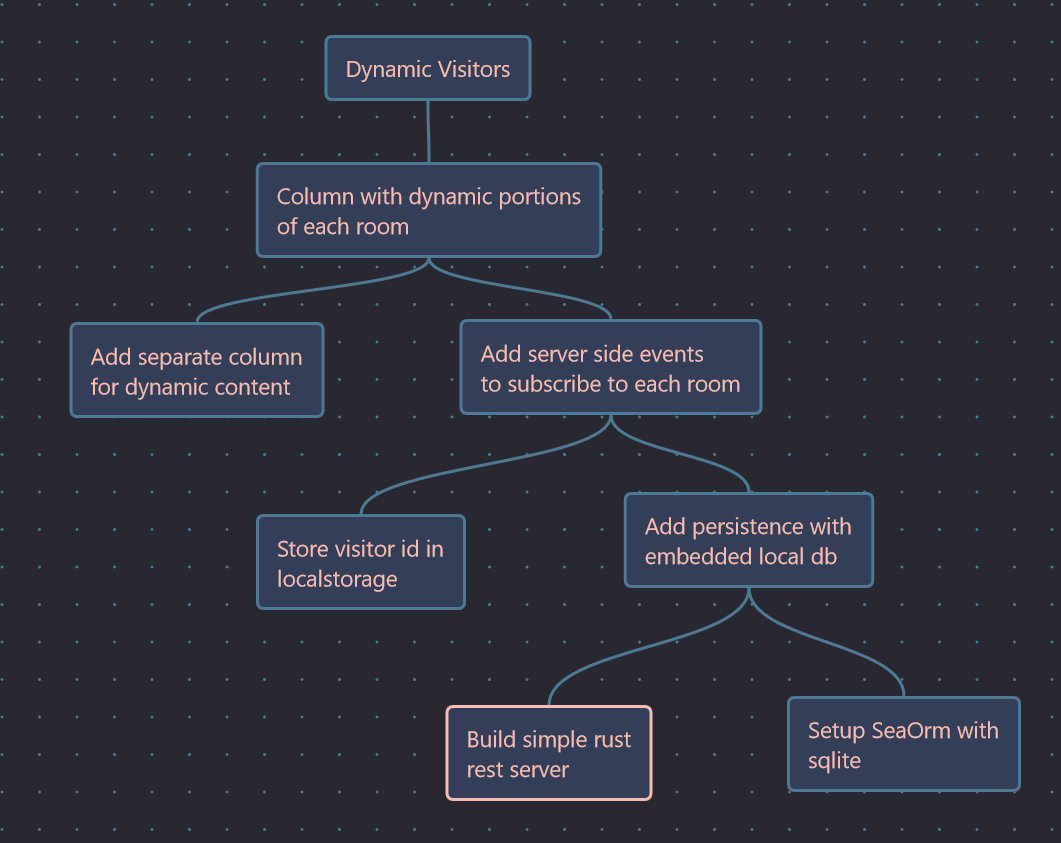Use Rocket to Create Blog Server Side
2023-04-26
This stop in the maple tree has an odd branch that has been coaxed up beside the pathway as it has grown making a table of sorts. From the table in regular intervals are small twigs sticking directly out of the wood. The twigs are twisted and conjoined into little humanoid shapes. Now that you have recognized them for what they are, you notice some gaps in the crowd of figures. In those gaps you can make out the beginnings of the same twigs, but short as though they have been cut at the feet.

Today I swapped over to working on the blog a bit more. I have talked about in the past the idea of having dynamic feedback for when other people are on the page. At the moment this site has some of the theming and flavor that I am looking for but none of the dynamic features. So today I worked on spinning up a basic rest server in rust which will someday power those more interesting features of the site.
Basic Data Model
Step one was to create a couple structs to model the live data for the website. I decided to postpone persisting the data to disk, so the initial approach has just enough information to get things off the ground.
I created a basic Room and Visitor which contain some simple
text that I expect to use when rendering in the future. I
also created a RoomSnapshot which can be serialized to
send over the wire.
Of note is the fact that each of the live structs have
parking lot RwLocks around them. This is because state in
Rocket apps must be thread safe. A read write lock for this
purpose is easy and plenty fine for my at least a while.
Rocket Route
Now that I had a place to store this information I wrote a route function that I expected the client side to request when visiting any of the pages on the site. This route would take a visitor_id to track who is who and a path to the current page from the site root. With that information it would fetch or create both the room in question and the visitor and update the state to represent the visitor being in that particular room.
Rocket heavily depends on convention to set this system up and looks at the type of the arguments as well as a specialized attribute to determine which kind of request this route should respond to.
The attribute specifies where in the url the visitor_id
and path should be parsed from and the &State<World>
argument tells the system that it should also pass the World
object to the function. Finally Json<RoomSnapshot> says
that it will return a RoomSnapshot object from the function
which should be serialized into Json to send back in the
response body.
Using the passed data is a bit verbose atm because I just
wanted to get something working, but the basic idea is to
compute the visitor id, get or create a new one, remove the
visitor from the previous room if they were seen there, get
or create the new room at path, add the visitor to the new
room, and return a RoomSnapshot.
let mut rooms = world.rooms.write;
let mut visitors = world.visitors.write;
// If the visitor_id is 0, create a new visitor id
if visitor_id == 0
// Get or create the visitor
let visitor = visitors.entry.or_insert_with;
// Remove the visitor from the previous room
let previous_room_path = visitor.current_room.read.clone;
if let Some = rooms.get_mut
// Get or create the room at path
let room = rooms.entry.or_insert_with;
// Add the visitor to the current room
visitor.current_room = new;
room.visitors
.write
.insert;
// Update the visitor's last seen time
visitor.last_seen = now;
// Return the room snapshot
let snapshot = RoomSnapshot ;
Json
Finally with the details hammered out, I wrote the rocket entry point which constructs a rocket instance, initializes the World state, and mounts the room route.
I then created a Rocket.toml file to specify that which port I wanted the server to run on to finish things up. A simple curl command confirms that everything is working!
# First request should return no other visitors
curl http://127.0.0.1:1248/room/0//
# Yields {"visitors":[]}
# Second request should have the previous visitor
curl http://127.0.0.1:1248/room/0//
# Yields {"visitors":["Maple Twig"]}
Eventually each request will likely return an updated visitor id and potentially other information, but for now this is good enough to move forward. The goal isn't to make some perfect rest service. Its only to make something good enough to power my blog and not much else, and given that this is all written in rust and pretty simple, I think it will fit the bill.
I also spent some time working on revamping the site css to handle a sidebar, but I will save those details for tomorrow's blog post.
Till tomorrow,
Kaylee